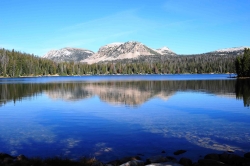
Courtesy Wyoming Department
of Transportation,
Talbot Hauffe, Photographer
 Kings Peak
Kings PeakCourtesy Wikimedia
Hyrum K. Wright, Photographer
Licensed under GNU Free Documentation License,
Hi, I’m Holly Strand.
Coming from Colorado, I’m something of a mountain snob. So while I always found Utah’s mountains to be agreeable, I admit to thinking they were somewhat petite. Then I saw the Uintas. About 200 miles long and 30-40 miles wide, the Uintas lie south of the Wyoming border primarily in northeastern Utah but with its eastern flank extending into Colorado.
There are several interesting features that make these mountains stand out in my mind.
For one thing, the Uintas are one of very few east-west trending mountain ranges of significant size on the planet. The only other one in N. America is the Brooks Range. This east-westness can feel strange to someone who orients themselves on a north-south axis. Because the path the sun follows the range instead of crossing it, my sense of direction was thrown off. Perhaps this happens to others too and that’s why we often hear about people getting lost in the Uintas.
Glaciation is another interesting aspect. The Uintas were more heavily glaciated than any other part of Utah. The most recent glacial episode was approximately 30,000 to 10,000 years ago. These Pleistocene glaciers left wide-bowl shaped valleys and scooped steep-walled cirques near the main ridge line. Nowadays, sparkling lakes, streams and meadows grace the ice-carved basins and valleys.
Speaking of lakes, even a Minnesotan might be impressed with the density of the Uinta Mountains lakes. Of course, the total number depends upon what you define as a lake. But most sources say there are between 800-1000 heavily concentrated in the High Uintas.
Utahns gets a lot their water from the Uintas. The mountains are an important source for several Wasatch Front rivers and streams including the Bear, the Weber, and the Provo. Precipitation and snowmelt on southern slopes either flow into the Duchesne River or directly into the Green River.
Because they are below 14,000 feet, the Uintas didn’t fit my Colorado-derived definition of “real mountains.” However there are 17 peaks all over 13000 feet–the highest is King’s Peak at 13,528 feet. Considering the beauty and wildness and the water features in these 13ers and their surroundings, the Uintas definitely scored with me. I’m looking forward to returning to explore some more.
For Wild About Utah, I’m Holly Strand.
Credits:
Images: Courtesy Wyoming Department of Transportation, Talbot Hauffe, Photographer
Courtesy Wikimedia, Hyrum K. Wright, Photographer
Text: Holly Strand
Sources & Additional Reading
Map of the Mirror Lake Scenic Byway, https://www.fs.fed.us/wcnf/unit/kamas/mirror_lake_scenic_byway_map.shtml
Guide to the Mirror Lake Scenic Byway, https://www.fs.fed.us/wcnf/unit/kamas/mirror_lake_scenic_byway.shtml
Biek, Bob. Grant Willis, and Buck Ehler. 2010. Utah’s Glacial Geology.
https://geology.utah.gov/surveynotes/articles/pdf/utah_glacial_geology_42-3.pdf
Dehler, C.M., Pederson, J.L., Sprinkel, D.A., and Kowallis, B.J., editors, 2005. Uinta Mountain
Geology: Utah Geological Association Publication 33, 448 p. https://www.utahmapstore.com/uga33.html
Hamblin, Kenneth. 2004. Beyond the Visible Landscape: Aerial Panoramas of Utah’s Geology. Provo: BYU
Jeffrey S. Munroe, Benjamin J.C. Laabs, Joel L. Pederson, and Eric C. Carson. 2005.
From cirques to canyon cutting: New Quaternary research in the Uinta Mountains
Field Guides, 6, p. 53-78. https://fieldguides.gsapubs.org/content/6
Kirkland, Gordon L. Jr. , 1981. The Zoogeography of the Mammals of the Uinta Mountains Region. The Southwestern Naturalist Vol. 26, No. 4.
Shaw, John and James Long. 2007. Forest Ecology and Biogeography of the Uinta Mountains, USA. Arctic, Antarctic and Alpine Research, Research 39(4): 614-628.
